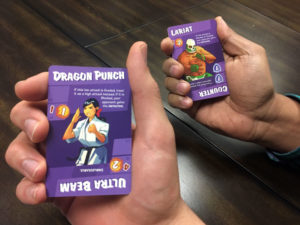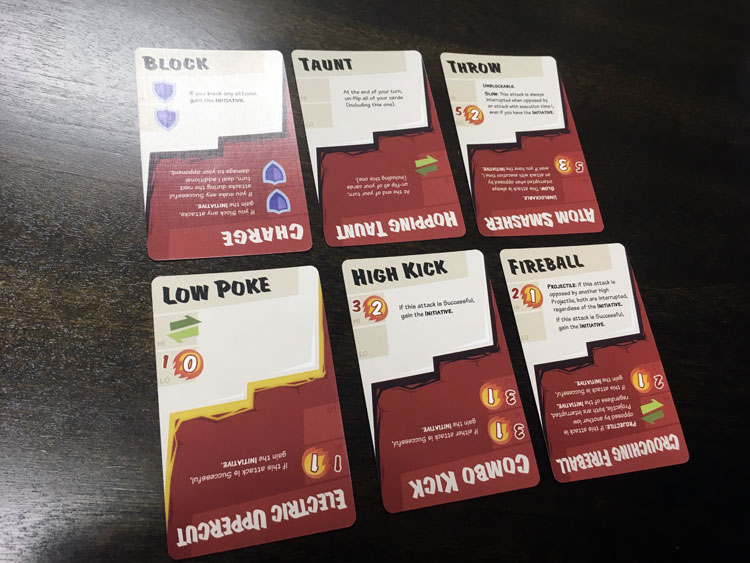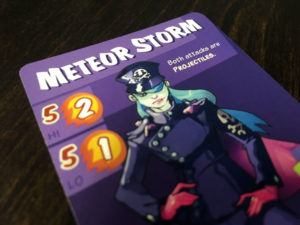 Karate Champ. Yie Ar Kung-Fu. Street Fighter. Learned students of video games will recognize these as some of the first electronic fighting games. Certainly these are the first to feature Asian fighting styles. Now, Level 99 Games, continuing a trend of bringing electronic nostalgia to the tabletop, has published something for the Hadouken-inclined gamer.
Karate Champ. Yie Ar Kung-Fu. Street Fighter. Learned students of video games will recognize these as some of the first electronic fighting games. Certainly these are the first to feature Asian fighting styles. Now, Level 99 Games, continuing a trend of bringing electronic nostalgia to the tabletop, has published something for the Hadouken-inclined gamer.
Dragon Punch is a card game of fighting for 2 players that takes about 5-10 minutes to play.
Game Overview:
Over the course of several turns, players will select cards that represent fighting moves. If a player lands a hit, the opponent takes damage. Once a player takes enough damage, they lose the game. Multiple games can be played for a match.
Game Components:

Dragon Punch is a small tin box offering with a single page rulesheet and small decks of cards which represent attack or defense moves. There are also cards which represent different fighters with special moves. The card quality is fine and the art is appropriate for this type of game.
As part of play, it is necessary to determine which player has “initiative”. A component to represent this, something easily substituted, appears to be the only thing missing.
How to Play:
Each player collects to their hand a preselected set of six cards with fighting moves and a character card. The character card also has unique moves to individualize each player’s deck.
The cards have two orientations on their faces. One orientation is the “undamaged” fighting move. If a card is rotated 180 degrees with the face still towards the player, the red “damaged” fighting move is now upright. Depending on the orientation of cards in a player’s hand, they keep track of how much damage they have taken and also allow the cards to present something of a catch-up mechanism. The damaged fighting moves are slightly more powerful.

Each turn, both players will select a fighting move card and then collapse their splayed hand of cards so that only the selected card is shown. Players can then dramatically reveal their cards and, as the rules suggest, “shout the name of your move out loud!”
Depending on the two selected moves, one player will take damage or both players will be unharmed. Some cards make high attacks. Some low. There are rules for determining the speed of an attack based on who has initiative and the overall speed of the selected move.
Once a fighting move has been used, it is rotated so that the card’s face is towards the opponent. The card is unusable until the player selects the “Taunt” card which returns all cards to face the player.
Play continues this way until one player has taken six damage as represented by six cards rotated 180 degrees to their red, damaged orientation. That player has lost the current fighting round. The best of three (or more) fighting rounds completes a match.

Game Experience:
Some readers will undoubtedly have reached this point of the review and are ready to click the Back link on the browser, or even worse, the Close button. What they may miss from the scant description above is that, despite the simplicity, there is a game here. It may only serve as a highly advanced form of rock-paper-scissors, but therein lies the heart of many fighting games.
People who have mastered games that revolve around predicting an opponent’s move already know that understanding your opponent’s personality is key. Dragon Punch gets this right. There are few other forms that a good fighting game can take with authenticity besides a war game with cards. This game sticks to the predictable presentation, and it does it well. The only twist offered is the Taunt move to recharge other moves.

The other aspect of fighting games Dragon Punch gets right is play time. If a tabletop fighting game lasts more than 15 minutes, something’s wrong. It’s intended to be an intense flailing of testosterone with clear winners and losers in less time than it takes to set up RISK.
Finally, the realization of quick personal play is the ability for the game to have a fight pop-up anywhere, just like a good action movie. Dragon Punch, with less than 40 cards in the tin, travels everywhere. It’s a great game to leave in the car for application to emergency boredom.
However, like any good thing, there could always be more of it. The lure of fighting is dampened by the limited scope of the game. Even with the variant play mode with customized decks, there isn’t much in the way of options. With only six basic moves and five characters, it gets stale with repeated use. With double the number of cards, the travelability could stay the same with immensely more options.
Final Thoughts:
Dragon Punch doesn’t aim too high. It isn’t sweeping any legs here with gameplay either. But for what it is, fighting game fans will be hit square in the solar plexus. Too much and, like any repetitive motion activity, it will wear out its welcome. But those who take Dragon Punch in their pocket for a quick fight while waiting at a restaurant, waiting for your Uber to arrive, or waiting for a good Street Fighter movie will welcome its diversion.
If you’d like to pick up a copy of Dragon Punch, you can get it for about $12.
Final Score: 4 Stars – Simplicity with just the right depth forms the travel size game perfect to play while waiting for… oh never mind 3, 2, 1 FIGHT!
 Hits:
Hits:
• Play time
• Theme to gameplay integration
• Travels easily
Misses:
• Needs more moves and characters




















